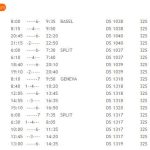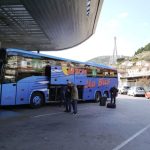In terms of location for a bus station, it is hard to beat Split. Stepping off the bus, one can almost walk onto the ferry, board the train or wander to the city’s main attraction, the 1,700 year-old Diocletian’s Palace.
Given the lack of coastal train routes (Split is only meaningfully connected with Zagreb by rail – click here for more info on Split train station), the bus is the most popular public transport option from other parts of Croatia to Split, and the city is well connected with routes to Zagreb, Dubrovnik and coastal destinations further north.
The bus station itself is quite small, and its waiting room includes a cafe. All other amenities are close by, including public toilets and luggage storage 20m to the right of the exit (another option is the storage lockers in the train station waiting room next door on the right – 15 kuna for 24 hours).
Timetables are available on the walls of the waiting room, but there are three other options for getting the information. The first is a very useful online timetable, which is both in English and easily navigable. The second is to ask the sales assistant for copies of the required timetable – all the timetables are available for free distribution as the sales counter. A third option is to check out our Split bus resource page, which we are building steadily, and which will include plenty of information about latest timetables and other bus-related information. Visit the page here.
Information already available on the page includes:
Bus times from Split to Dubrovnik and back
Bus times from Split to Zagreb and back (when travelling to Zagreb, check which buses are going via the motorway – much quicker)
Bus times from the station to the airport in Split
There is a Jadrolinija ferry ticket office across the street from the station, or turn left and head to the main ferry building 50m, where you can also buy tickets with other ferry companies such as Blue Line. Luggage porters, such as the in the picture above, are freely available.
Sales staff speak English. Tickets will include the platform (‘peron’), all of which are clearly numbered in front of the station. Luggage is stored in the undercarriage of the bus, and there is a charge for this.










